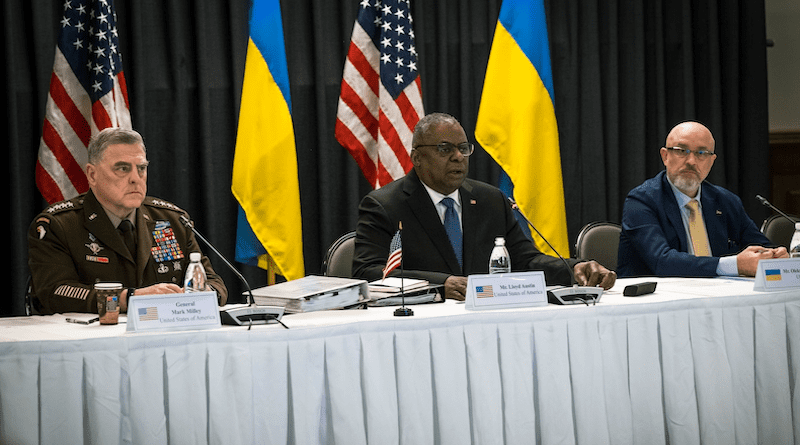Contact Group Aids Ukraine’s Current Battle, Looks To Long-Term Assistance
By DoD News
By Jim Garamone
Secretary of Defense Lloyd J. Austin III announced President Joe Biden’s approval of the transfer of $675 million worth of U.S. military capabilities to Ukraine, but the emphasis of the Ukraine Defense Contact Group meeting at Ramstein Air Base, Germany, is on long-term assistance to the nation as it confronts the Russian invasion.
Austin convened the in-person meeting of the group saying the more than 50 nations involved are looking to intensify the momentum for aiding Ukraine.
Austin told the group that President Joe Biden had approved the latest tranche of U.S. assistance to Ukraine. It is the 20th drawdown of equipment from U.S. stocks for Ukraine since August 2021.
“The latest package includes more [guided multiple launch rocket systems], 105-millimeter howitzers, artillery ammunition and [high-speed anti-radiation missiles], Humvees, armored ambulances, anti-tank systems, small arms and more,” he said. “And since our last meeting in July, many allies and partners have come forward with their own important new deliveries of advanced radars, tanks, and armored personnel carriers.”
Austin and Army Gen. Mark A. Milley, the chairman of the Joint Chiefs of Staff, met with Oleksii Reznikov, Ukrainian defense minister, and Lt. Gen. Yevhen Moisiuk, Ukrainian deputy chief of defense, before the group convened. The Ukrainians gave updates on battlefield conditions in the country and their military needs.
This is the fifth meeting of the contact group, which held its first meeting at Ramstein in April. At that time, Ukraine had stopped Russian attacks on Ukraine’s capital of Kyiv.
“In late April, Russia shifted to massive artillery strikes against sovereign Ukrainian territory in the Donbas,” Austin said in introductory remarks. “And this contact group responded swiftly to the changing character of Russia’s war of choice.”
The United States committed unprecedented security assistance to Ukraine including Stinger anti-aircraft systems, armored personnel carriers, grenade launchers, Mi-17 helicopters, body armor, and millions of rounds of small-arms ammunition.
The secretary used the transfer of howitzers as an example of the assistance that has poured into Ukraine. “In April, the United States delivered our first batch of M-777 howitzers — introducing NATO-standard artillery pieces to Ukraine for the first time,” he said. “Today, the United States has delivered 126 of those howitzers. And along with countries around the world, we’ve increased the number of howitzer systems for Ukraine’s defenders by more than 18-fold.” This helped freeze the Russian offensive in the Donbas region.
Since then, more capabilities including 26 long-range rocket artillery systems and the associated guided multiple launch rockets have arrived.
“All these capabilities have demonstrably helped Ukraine fight back against Russia’s aggression,” he said. “And they have enabled Ukraine to resist Russia’s ongoing onslaught. So we have come a long way by working together.”
But more needs to happen. Russia continues to bombard Ukrainian cities and civilians with missiles and artillery fire. But the nature of the war is changing again and Ukrainian forces have begun a counteroffensive in the southern part of the country, the secretary said.
“They are integrating the capabilities that we all have provided to help themselves to fight and reclaim their sovereign territory,” Austin said. “Today, this contact group needs to position itself to sustain Ukraine’s brave defenders for the long haul.”
The world needs to supply Ukraine the capabilities it needs to fight today, but it also needs the means and training to defend the country for the future and deter Russia. “It means moving urgently to innovate, and to push all of our defense industrial bases to provide Ukraine with the tools that it will need for the hard road ahead,” Austin said. “We’re here because we refuse to live in a world where big powers trample borders by force. Our support for Ukraine’s bedrock right to defend itself doesn’t waver based on any given clash.”
The war in Ukraine is changing, the secretary said, “and so is the mission of this Contact Group.”
The secretary said the group needs to consider long-term aid to Ukraine. “We’ll work together to train Ukraine’s forces for the long haul,” he said. “We’ll work together to help integrate Ukraine’s capabilities and bolster its joint operations for the long haul. We’ll work together to upgrade our defense industrial bases to meet Ukraine’s requirements for the long haul. And we’ll work together for production and innovation to meet Ukraine’s self-defense needs for the long haul.”
Ukraine is making progress against a much larger foe. “And every day, we see the resolve of the allies and partners worldwide who are helping Ukraine resist Russia’s illegal, imperial and indefensible war of conquest,” he said. “And we must evolve as the fight evolves.”
There have been significant contributions from many other nations. Britain has provided 2.3 billion pounds of equipment to Ukraine. Germany and Denmark have both announced significant packages of military assistance. Poland — a frontline state facing Russia — has transferred three battalions of 155 mm self-propelled howitzers to Ukraine.
Other contact group nations work not only on contributions, but on helping train Ukrainian service members.

